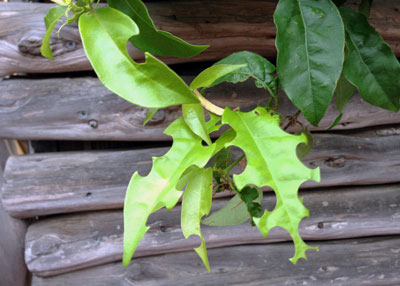Question of the Week – Number 1: July 8, 2021

“What caused this unusual damage to the leaves of my crossvine? I’ve never seen any kind of an insect.”
This was, indeed, done by an insect. In fact, it’s an insect I really have to admire. Not that I’d wish this kind of damage on anyone’s crossvine, petunia or roses – or any other kind of landscaping plant, but it’s just a creative existence.
This is the work of a leaf cutter bee. These ingenious bees are solitary insects. They build their nests using these cut-out leaf tissues for the outsides and similar floral tissues for the insides, all wrapped together with nectar in the middles to nourish the developing larvae.

They are about the size of honeybees, but generally much darker (almost black). Like more common honeybees, they are also beneficial pollinators, some notably for alfalfa.
However, you’ll rarely see them around your plants. They gather their little circles of leaf and flower parts and fly back to a constricted space in a tree trunk, water faucet or other similar spot to build their nests. When you eventually turn on the faucet you’ll discover the dried nest as it blows out onto your shoes.
Because they actually don’t feed on the plant tissues, and because they’re around the plants for only a few minutes, sprays are of very limited value. The bees are not really doing much measurable damage to the plants anyway, so unless they’re ruining your plants’ looks, you might as well learn just to brag about them.
So that’s what I can tell you about leaf cutter bees. However, I did do an hour’s research online, and I found several good links in case you’d like to see and read more.
North Carolina State University’s website. Excellent explanation of how they do their work.
https://content.ces.ncsu.edu/leafcutter-bees
Nature Science Beautiful Now. Great photos of leaf cutter bees so you can see what they look like.
https://tinyurl.com/52yrhx22
Video of bee nest site.
https://www.youtube.com/watch?v=Stq083Jd90A
